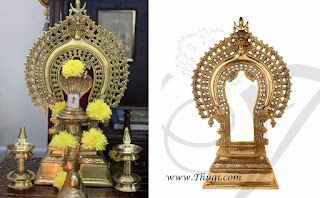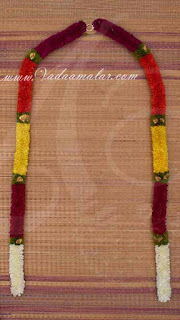Lord Ganesha is also known as Ganapati, Vinayaka, Pillaiyar and Binayak, is one of the best-known and most worshiped deities in South Asia.People seeking happiness, peace and prosperity in life should consider placing an idol of a Ganesha at home.
Ganesh is widely revered as the remover of obstacles, the patron of arts and sciences and the deva of intellect and wisdom. As the god of beginnings, he is honored at the start of rites and ceremonies.
One popular way is to place an idol of Lord Ganesha just
opposite to the main entrance of your home. It is believed that this
Drishti Ganesha will ward off all the evil from entering your home and
bring prosperity. When you place Lord Ganesha this way, he will be the
guardian of your home.
Having a Ganesh idol at home or office space ensures a harmonious environment and helps keep negative energies away.
Decorations for Ganesh Murthi
Crown : 'Mukut' or the crown is an integral part of Lord
Ganapathi. It can be in different colours and stones. It represents power, legitimacy, victory, honour,
resurrection and glory.
Dhoti : Dhoti in cotton or silk or Poly Silk fabric for the
Murthi is ideal. Simple hand-woven cotton Vesti is used in many Pillyar idols.
These can be washed an reused. You can also cut your silk dupatta or saree to
make a dhoti. Alternatively, you can procure readymade dhoti from the market;
these are ready-to-wear and available in many vibrant colours.
Jewellery : Lord Ganesh often wears pearls and serpents as
ornaments. Haram (Long necklace) upto is belly can be seen in many idols. Bells
on his feet reveal that he is a dancer.
Flowers : Choose various flowers of different shades and arrange them in
beautiful patterns. Or if you want to re-use go for cloth flowers or Vagamala
Fruits : Keep a coconut and a small bowl of grains alongside
the Vinayak idol.
Sweets : It is believed
that Lord Ganesha was a fan of ladoos and modak—a sweet dumpling filled with
jaggery and coconut made from rice or wheat flour.
Weapons of Lord Ganesha
#1 Conch Shell:
Ganesha typically holds a conch shell. Conch shell symbolizes victories. Conch shells symbolize victory and fulfillment. Thus, Lord Ganesha holding a conch shell in his hand represents nothing else but the fact that God blesses his devotees with victory and fulfillment in all the wars.
#2 Lotus Flower:
Lotus represents enlightenment. Ganesha can bless you with enlightenment, if you so desire. Weapon (usually an axe or a lasso) symbolizes removal of your obstacles or delivery of justice.
Like a lotus exists in water without touching it, in the same way, we should live a life without letting the world or the outer environment changing us- then only is it possible to remain in constant touch with our inner consciousness and eventually achieve spiritual happiness
#3 The Axe or The Sword:
This weapon symbolizes how we should not fear any obstacles and cut away all the difficulties that arise in our lives.
#4 Whip:
The whip conveys that worldly attachments and desires should be rid of.
#5 Noose (pash) / lasso
The noose signifies that Ganesha has the ability to captivate and annihilate the negative forces. The pasha (noose) symbolises the rope of spiritual wisdom, the force that will remove us from the material world and its attachments. The rope ties down the wild elephant-like mind which runs from here to there. It controls and tames it.
#6 Goad (ankush)
It signifies that Ganesha is the destroyer raja (destructive) forces. He guides our way towards attainment of bliss and knowledge.
#7 Abhaya Mudra:
The Abhaya mudra is a representation of the Lord’s care, protection and blessings over his mortal devotees and worshippers. This, in turn, means that the Lord welcomes all to approach him conveying to them that he is not there to punish,judge or harm them in any way.
The fourth hand of Lord Ganesha is usually empty and it is seen in an uplifted raised blessing position which is specifically called the “Abhaya Mudra”.































































